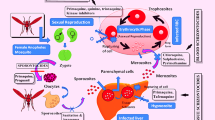Abstract
Several new chalcone analogues were synthesized and evaluated as inhibitors of malaria parasite. Inhibitory activity was determined in vitro against a chloroquine-sensitive Plasmodium falciparum strain of parasites. The compound 3-(4-methoxyphenyl)-1-(4-pyrrol-1-yl-phenyl)prop-2-en-1-one was found to be the most active with 50% inhibition concentration (IC50) of 1.61 μg/ml. This inhibitory concentration is comparable to a prototype phytochemical chalcone, licochalcone A, with an IC50 of 1.43 μg/ml. The present study suggests that small, lipophilic nitrogen heterocyclic ring A together with small hydrophobic functionality at ring B can enhance antimalarial activity. These results suggest that chalcones are a class of compounds that provides an option of developing inexpensive, synthetic therapeutic antimalarial agents in the future.
Graphical Abstract
Claisen-Schmidt condensation method was employed to synthesize various substituted chalcones. Among all, 3-(4-Methoxyphenyl)-1-(4-pyrrol-1-yl-phenyl)prop-2-en-1-one was found to be most effective with IC50 value of 1.6 μg/ml in vitro against chloroquine sensitive strain (3D7) of Plasmodium falciparum.




Similar content being viewed by others
References
Bhakuni DS, Chaturvedi R (1984) Chemical constituents of Crotalaria madurensis. J Nat Prod 47:585–591. doi:10.1021/np50034a003
Bhasin VK, Nair L (2003) ACT now—with caution—for malaria treatments. Lancet Infect Dis 3:609. doi:10.1016/S1473-3099(03)00767-9
Bhattacharya A, Mishra LC, Bhasin VK (2008) In vitro activity of artemisinin in combination with clotrimazole or heat-treated amphotericin B against Plasmodium falciparum. Am J Trop Med Hyg 78:721–728
Budavari S, O’Neil MJ, Smith A, Heckelman PE (1989) The Merck Index, 11th edn. Merck: Rahway, NJ, p 746
Cheenpracha S, Karalai C, Ponglimanont C, Subhadhirasakul S, Tewtrakal S (2006) Anti-HIV–1 protease activity of compounds from Boesenbergia pandurata. Bioorg Med Chem 14:1710–1714. doi:10.1016/j.bmc.2005.10.019
Chen M, Theander TG, Christensen BS, Hviid L, Zhai L, Kharazmi A (1994) Licochalcone A, a new antimalarial agent, inhibits in vitro growth of the human malaria parasite Plasmodium falciparum and protects mice from P. yoelii infection. Antimicrob Agents Chemother 38:1470–1475
Dimmock JR, Elias DW, Beazely MA, Kandepu NM (1999) Bioactivities of chalcones. Curr Med Chem 6:1125
Dominguez JN, Leon C, Rodrigues J, De Dominguez NG, Gut J, Rosenthal PJ (2005) Synthesis and evaluation of new antimalarial phenylurenyl chalcone derivatives. J Med Chem 48:3654–3658. doi:10.1021/jm058208o
Dyke SF, Kinsman RG (1981) Properties and reactions of isoquinoline and their hydrogenated derivatives. In: Grethe G (ed) Hetrocyclic compounds isoquinolines. Wiley, New York, pp 3–10
Hawley SR, Bray PG, O’Neill PM, Park BK, Ward SA (1996) Role of drug accumulation in 4-Aminoquinoline antimalarial potency. Biochem Pharmacol 52:723–733. doi:10.1016/0006-2952(96)00354-1
Khatib S, Nerya O, Musa R, Shmuel M, Tamir S, Vaya J (2005) Chalcones as potent tyrosinase inhibitors: the importance of a 2,4-substituted resorcinol moiety. Bioorg Med Chem 13:433–441. doi:10.1016/j.bmc.2004.10.010
Klayman DI (1985) Qinghaosu (Artemisinin): an antimalarial drug from China. Science 228:1049–1055. doi:10.1126/science.3887571
Lambros C, Vanderberg JP (1979) Synchronization of Plasmodium falciparum erythrocytic stages in culture. J Parasitol 65:418–420. doi:10.2307/3280287
Li R, Chen X, Gong B, Selzer PM, Li Z, Davidson E, Kurzban G, Miller RE, Nuzum EO, McKerrow JH, Fletterick RJ, Gillmor SA, Craik CJ, Kuntz LD, Cohen FE, Kenyon GL (1996) Structure-based design of parasitic protease inhibitors. Bioorg Med Chem 9:1421–1427. doi:10.1016/0968-0896(96)00136-8
Liu M, Wilairat P, Croft SL, Tan ALC, Go ML (2003) Structure–activity relationships of antileishmanial and antimalarial chalcones. Bioorg Med Chem 11:2729–2738. doi:10.1016/S0968-0896(03)00233-5
Mishra LC, Bhattacharya A, Bhasin VK (2007) Antiplasmodial interactions between artemisinin and triclosan or ketoconazole combinations against blood stages of Plasmodium falciparum in vitro. Am J Trop Med Hyg 76:497–501
Mishra N, Arora P, Kumar B, Mishra LC, Bhattacharya A, Awasthi SK, Bhasin VK (2008) Synthesis of novel substituted 1,3-diaryl propenone derivatives and their antimalarial activity in vitro. Eur J Med Chem 43:1530–1535. doi:10.1016/j.ejmech.2007.09.014
Nielsen SF, Larsen M, Bosen T, Schonning K, Kromann H (2005) Cationic chalcone antibiotics. Design, synthesis, and mechanism of action. J Med Chem 48:2667–2677. doi:10.1021/jm049424k
Phillips RS (2001) Current status of malaria and potential for control. Clin Microbiol Rev 14:208. doi:10.1128/CMR.14.1.208-226.2001
Robinson TP, Hubbard RB IV, Ehlers TJ, Arbiser JL, Goldsmith DJ, Bowen JP (2005) Synthesis and biological evaluation of aromatic enones related to curcumin. Bioorg Med Chem 13:4007–4013. doi:10.1016/j.bmc.2005.01.009
Satyanarayana M, Tiwari P, Tripathi BK, Srivastava AK, Pratap R (2004) Synthesis and antihyperglycemic activity of chalcone based aryloxypropanolamines. Bioorg Med Chem 12:883–889. doi:10.1016/j.bmc.2003.12.026
Schmidt BM, Ribnicky DM, Lipsky PE, Raskin I (2007) Revisiting the ancient concept of botanical therapeutics. Nat Chem Biol 3:360–366. doi:10.1038/nchembio0707-360
Shenai BR, Sijwali PS, Singh A, Rosenthal PJ (2000) Characterization of native and recombinant falcipain-2, a principal trophozoite cysteine protease and essential hemoglobinase of Plasmodium falciparum. J Biol Chem 275:29000–29010. doi:10.1074/jbc.M004459200
Snow RW, Guerra CA, Noor AM, Myint HY, Hay SI (2005) The global distribution of clinical episodes of Plasmodium falciparum malaria. Nature 434:214. doi:10.1038/nature03342
Trager W, Jensen JB (1976) Human malaria parasites in continuous culture. Science 193:673–675. doi:10.1126/science.781840
Valla A, Valla B, Cartier D, Le Guillou R, Labia R, Florent L, Charneau S, Schrevel J, Potier P (2006) New syntheses and potential antimalarial activities of new ‘retinoid-like chalcones’. Eur J Med Chem 41:142–146. doi:10.1016/j.ejmech.2005.05.008
WHO (1997) World malaria situation in 1994. Wkly Epidemiol Rec 72:269–274
WHO (1998) The use of artemisinin and its derivatives as anti-malarial drugs. Report of a Joint CTD/DMP/TDR Informal Consultation, Geneva, 10–12 June 1998. Geneva, World Health Organization. WHO/MAL/98.1086
WHO (2006) Guidelines for the treatment of malaria. World Health Organization
Acknowledgements
S.K.A. is thankful to University Grant Commission (UGC), New Delhi, India (scheme no. F-12-19/2004) and University of Delhi, Delhi, India for financial support. This work was partly supported by the Department of Biotechnology, Ministry of Science and Technology, Government of India. Both A.B. and L.C.M. received fellowships from the Council of Scientific and Industrial Research (CSIR), New Delhi.
Author information
Authors and Affiliations
Corresponding author
Rights and permissions
About this article
Cite this article
Awasthi, S.K., Mishra, N., Kumar, B. et al. Potent antimalarial activity of newly synthesized substituted chalcone analogs in vitro. Med Chem Res 18, 407–420 (2009). https://doi.org/10.1007/s00044-008-9137-9
Received:
Accepted:
Published:
Issue Date:
DOI: https://doi.org/10.1007/s00044-008-9137-9




